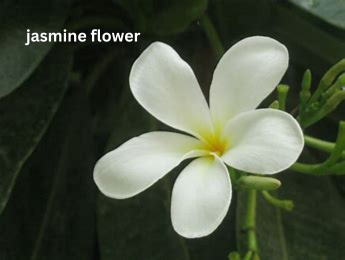Jasmine flowers:
Jasmine flowers are well-liked for their astounding scent and immaculate appearance. After they reach adulthood, these are likewise not very demanding and thrive on neglect. Jasmine blooms grow well on wall-side borders, trellises, arbors, and hedges. These are a few of the greatest varieties of jasmine flowers, known for their wonderful scent!
Among the more than 200 species of perennial plants in the Oleaceae family is the well-known jasmine flower. The most well-known feature of this white, creeping blossom is its scent, which is exquisite in any yard or garden and frequently imitated in perfumes.
Most jasmine species are found in tropical and subtropical regions of the world, where they grow as shrubs or vines. Depending on the species, plants can have varying leaves and be either evergreen or deciduous.
Glossy, waxy, dark green leaves are a common sight. Delicate flowers in shades of yellow, gold, white, or pink can appear single or in clusters of three. They are also incredibly fragrant and prolific.
Types of Jasmine:

Types of Jasmine J. officinale: Known as True or Poet’s jasmine, this huge, deciduous or evergreen, vining shrub can withstand temperatures ranging from 7 to 10 degrees Celsius. White flowers in large clusters bloom late spring to early autumn.
J. nudiflorum: This medium-sized deciduous shrub has long, arching branches that are perfect for Winter jasmine. In springtime, bright yellow blooms bloom. USDA growth zones 6 through 10 are suitable for this species.
J. rex: Hardy in USDA growing zones 10 and 11, royal jasmine is a compact vine that grows quickly. Up to nine feet long vines swiftly envelop supports and yield nearly year-round pure white blossoms.
J. polyanthum: Pink jasmine is a quickly spreading evergreen vine that blooms profusely in late winter or early spring with pinkish-white blossoms.
petals
Keel Wing Labellum Banner Hypochile – Related Topics
Common peony in Europe
Common peony in EuropeThe common peony of Europe, Paeonia officinalis.
Petals are sterile floral parts found in blooming plants that typically serve as a flower’s most noticeable feature. Modified leaves, called petals, are frequently brilliantly colored to draw particular pollinators to the bloom. In monocots, petals typically occur in sets of three, while in eudicots, they typically occur in sets of four or five. Many horticultural flowers, including peonies and roses, have been grown to produce spectacular, complex blooms by adding layers of petals to their petals.
anatomy of flowers
anatomy of flowers Angiosperm diagram representing a typical flowering plant.
The petals and sepals, two sets of sterile appendages that are linked beneath the fertile sections of the flower, the pistils and stamens. A flower’s corolla is made up of all of its petals, and the calyx is made up of all of its sepals. The term “perianth” refers to the combination of the calyx and corolla. Similar to petals, sepals are modified leaves that envelop and shield the flower bud.
They are typically green and rather rough. In contrast, petals are available in a wide range of colors and are frequently thinner and more delicate than sepals. Some flowers, including many lilies and orchids, have petals and sepals that resemble one another almost exactly; these undifferentiated elements are called tepals.
cherished flower
cherished flower The radiating head of the daisy-like inflorescence made up of disk blooms that is known as the treasure flower (Gazania rigens).
Methods for Making Jasmine Bloom:
jasmine flower jasmine music banner abundantly and consistently when they are kept warm, consistently hydrated, and exposed to enough bright sunlight.
Months of Bloom:
According to their USDA growth zones, different jasmine species bloom at different times of the year. For instance, royal jasmine flower indoor plant nearly year-round in its hardiness zone, whereas pink jasmine can only bloom in late winter or early spring.
Does Jasmine Bloom for How Long?
Depending on the species, bloom times might last anywhere from one to two months. Some plants that are cultivated in warmer hardiness zones could bloom continuously throughout the year.
How Do Jasmine Flowers Smell and Look?
Single or double blooms are possible, and single blooms are often tubular and star-shaped. five petals. They can be found alone or in groups of three blooms, each with four to nine petals. Shades of yellow, white, and pinkish white are among the colors. Typically, flowers are abundant but little, measuring just an inch in diameter. jasmine flower tattoo are prized for their aroma in both aromatherapy and the perfume industry. The fragrance is rich, sweet, and fruity with a hint of muskiness. It is light but complex.
FAQ:
How long can jasmine live?
The species of the jasmine flower jasmine music banner plant and whether it is grown in its USDA hardiness zone have an impact on its lifespan. While many jasmine plants only last five to ten years on average, they can live much longer with proper maintenance.
In what area of my home should I plant jasmine?
A potted jasmine flower plant indoors looks best near a south-facing window.
What other plants resemble jasmine?
Plants like gardenia, plumeria, and honeysuckle have sweet blossoms and a similar appearance. Many plants that are often frequently referred to as jasmine really belong to a different genus. Among them, star Jasmine is the most well-liked.
Is caring for jasmine a difficult task?
Jasmine is not thought to require a lot of upkeep. Plants do, however, need care and attention when they are first planted.
for more information visit our Homepage



